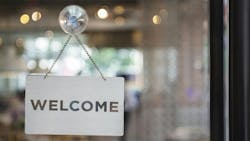The atmosphere of a retail establishment is immediately noticeable to a guest when they enter. We have all walked into a restaurant that is mostly empty and quiet where the staff doesn’t acknowledge your arrival. You might even have had the reaction, “Are they open?”
Compare that to the experience of walking into your local favorite spot, which is bustling with energy and where the team acknowledges your arrival, greeting you warmly by name. These are two very different retail atmospheres.
At Oilstop, we call this “store atmosphere.” The store atmosphere is a palpable reflection of the environment we’ve created for our guests to enter. A good store atmosphere is vital to creating an environment where you can welcome guests, serve them, and provide an experience that will cause them to return. Creating the recipe for a positive store atmosphere involves two key ingredients.
The first ingredient to create a positive store atmosphere is setting the “temperature of the store.” The temperature of a store is the energy of your store and team. In the quiet and empty restaurant described above, the store’s temperature is low. The team is quiet, tired, non-responsive, and not engaging. This low temperature doesn’t create a positive environment for guests to feel welcomed.
However, a high temperature isn’t necessarily a great experience either. When the team’s temperature is too high it can cause an environment where the team appears stressed, chaotic, and frenetic. This high temp can cause mistakes to be made and guests to feel rushed. A crowded Costco at peak time is a good example of the temperature being too hot. Entering an overcrowded Costco is more stressful than welcoming.
Identifying the right temperature for your store is an important step for guiding your team to set the temperature for the store. The right temperature for your store will vary depending on what type of environment you want to create. The best temperature for a library is different from the best temperature for a bustling beer hall.
Deciding and communicating with your team about your desired temperature of your store is the equivalent of setting the temperature on the thermostat in your home. On a hot day, the temperature will begin to creep up, but your thermostat will adjust and bring the temperature down.
Once you’ve clearly communicated the expected temperature of your store to your team, on a busy day when things begin to get stressful, rushed and frenetic, your leaders will notice and slow things down. On a quiet day, the leaders in your store can help bring the team’s energy up. At Oilstop, we train our store managers to help set the store temperature to best create an environment of hospitality and efficiency.
The second tenant to create a positive store atmosphere is having good language in your store. Compare a shop where the team is angry at one another, cursing, and not communicating well, to a burger counter where the cashier calls out the order to the cook who repeats it back and immediately fires up the grill.
Strong bay calls from a lube tech to a service writer help communicate thoroughness or a sense of urgency to guests. When a good waiter arrives at your table and communicates the daily specials with ease and confidence, it increases your confidence in how those specials might taste.
If the waiter can’t remember the specials, are you really going to trust it’s the best option on the menu? Clearly training the language of your store to your team will help control the store atmosphere. This takes intentionality in deciding what kind of store atmosphere you want to create. Some quick lubes might opt for loud boisterous bay calls, while others might focus on calm confidence in their presentations to guests.
At Oilstop we have opted for loud and positive bay calls in our stores to create an atmosphere of urgency, excitement, and confidence. But we don’t want our techs to loudly yell certain things out. For example, “I just stripped the drain plug thread,” isn’t something we want called out loudly to the bay.
So, we created a code system for things that should be communicated privately or quietly. “Code 5” means “I need help or a word in private.” So, our lube tech might call Code 5 for their manager to come help them out and communicate the issue with the guest. We have codes for when a guest says “no” to a service (Code 10), for when a technician needs to put on safety glasses (Code 4), and even for when a team member demonstrates our mission statement in action (Code 1). These codes help us control the language of the store to help create a positive store atmosphere for our guests.
Setting the temperature of your store and setting the language of your store are two important ways to help create a store atmosphere that is positive for your guests. And when the store atmosphere is positive, your guests will come back!
About the Author
Scott Hempy
Scott Hempy leads the team at Oilstop Drive-Thru Oil Change and Happy's Drive-Thru Car Wash. Oilstop and Happy's are rapidly growing their footprint of oil change and express car wash locations across the West Coast, combining convenience with an outstanding emphasis on guest experience. Prior to Oilstop & Happy's, Scott was the founder and CEO at Filld, a SaaS-based software solution for last-mile oil and gas delivery companies. He was recognized as a member of the Forbes 30 Under 30 class of 2016 for starting Filld.
